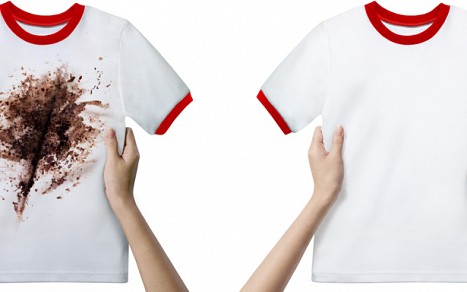
Chemical bleaches.
Synthetic surfactants are the most effective in removing grease, besides, also a large proportion of the tea stains, coffee, fruit juices etc.. However, for the complete removal of colored stains, chemical bleaches are introduced into the detergent composition (active bleaches).
Chemical bleach is an oxidant, i.e.. substance, which in the washing bath has the ability to oxidize the pigments of the dirt, causing them to turn into a colorless form. During this process, the oxidant is reduced.
The well-known bleach, and also the substance used for disinfecting purposes is sodium hypochlorite. This relationship breaks down easily, especially at elevated temperatures, releasing active chlorine. Sodium hypochlorite solutions are the basis of many bleaching agents, used as household chemicals, such as: Clorox, Chlorine, Bleach, Bielinka, ACE and Domestos. These agents are used as chemical bleaches for fabrics and as bleaching and disinfecting agents in keeping sanitary facilities clean..
The chemical bleach currently dominant in washing powder compositions in Europe is sodium perborate. (Hypochlorite remains the standard bleach in Australia and Asia). Sodium perborate, decomposing in the washing bath at a temperature above 60 ° C, releases active oxygen, works whitening the dyes, dirt.
In order to increase the effectiveness of washing powders at lower temperatures, an activator is used, which is mostly TAED (tetraacetyloetylenodiamina). TAED lowers the temperature, where active oxygen begins to be released, thanks to which the powders gain whitening power at temperatures 40 — 60°C. Another activator, used in agents containing perborate, is the sodium salt and is abbreviated as NOBS. An alternative is to use sodium percarbonate as the bleaching agent. Chemical bleaches are mainly used as an ingredient in washing powders, they are not used in washing liquids, which, as a rule, are intended for washing delicate fabrics.
When using agents containing chemical bleaches, remember, that by bleaching stains, these agents also affect the dyes of colored fabrics. Washing colored products in powder with chemical bleach, even at lower temperatures, can cause color fading especially, when the powder contains an activator (np. TAED). At the same time, it should be emphasized, that the excessive use of agents containing chemical bleaches leads to gradual deterioration of the fabric and a decrease in its strength.